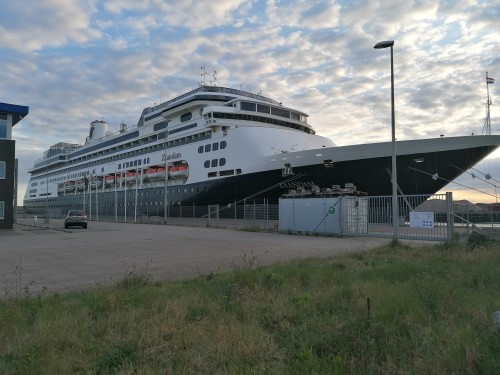At the beginning of 2020, the future of cruising looked as bright as ever. High growth rates, 30 million passengers cruising in 2019, 120-plus vessels on order until 2027 of which an impressive 40 newbuildings were (soft-)expedition ships. Then the Corona/ COVID-19 pandemic -which had started in China already at the end of 2019- spreaded to other Asian Countries and the rest of the world.
On February 20, the World Health Organization announced that more than half of the known cases of COVID-19 in the world outside China at the time were on a cruise ship, the Diamond Princess. She was kept in quarantine in Yokohama, Japan with more than 3700 people on board (passengers and crew) who were confined to their cabins. Finally, March 1, all passengers and crew members had disembarked from the ship .

After several outbreaks on board cruise ships, ports started to be cautious and applied strict rules concerning admitting them. Soon, vessels with (possibly) infected passengers on board were refused by most ports. For example Holland America Cruises’ Westerdam had left the port of Hong Kong on February 1 for a cruise to Taiwan and Japan. But when it became known that she had COVID-19 infected passengers on board, the ports of Thailand, Guam, the Philippines and Japan refused Westerdam to dock. Finally, she was permitted to call at Sihanoukville, Cambodia to offload guests.
When it became clear that cruising would come to a worldwide halt for a longer period and ships were laid up, cruise lines faced the almost impossible task of repatriating crew as air travel had also been largely shut down. They ferried crew home using their out-of-work vessels. (see my article https://www.cruiseshipodyssey.com/corona-covod19-cruise-ships-in-the-netherlands/ ).
More and more cruise lines laid up their vessels and they “parked” them in ports like for example Southampton, Poole Bay, Weymouth for Cunard and P&O vessels, Grand Bahama (several Carnival ships), Miami, Manilla Bay etc. or out at sea. These ships periodically make technical calls entering nearby ports for provisioning and refuelling.
Ships are mostly kept in what is called soft lay up, meaning that a skeleton crew remains on board and all facilities are kept active. These ships can return to service relatively simple. To save money, vessels are in some cases put in cold lay up, meaning that there is no crew aboard and the everything like generators is completely shut down. Cruise lines burn a vast amount of money monthly, for example looking at the big three: Carnival Cruises $500 mio, Royal Caribbean Cruises $275 mio and NCL $175 mio.

At the beginning of the pandemic, Cruise & Maritime Voyages (UK) and Pullmantur (Spain) soon went out of business, followed by Swedish Birka Cruises. Also German tour operator FTI pulled out of the cruise business. Jalesh Cruises from India sold their ony ship Karnika for scrap and finally Bahamas Paradise Cruise Line was forced to sell one of their ships, the Grand Celebration for scrap to cover outstanding crew wages and keep the company afloat.
Several older, often smaller and less efficient ships were offloaded and sold for scrap like for example Carnival Fantasy (1990), Carnival Imagination (1995) and Carnival Inspiration (1996), all of them perfectly maintained with many years of service left in them, but because of their age and relatively small size not profitable enough anymore. These days, cruise lines need to be as efficient as possible and this is one way they prepare for the future after the pandemic will have finally ended. For an overview of vessels scrapped see my retired ships page.

Other cruise lines jumped at the opportunity to acquire ships at very favourable prices, in many cases just above scrap value. Fred Olsen Cruises bought the Rotterdam and Amsterdam (to be renamed Borealis and Bolette) from Holland America and Celestyal Cruises added Costa Cruises’ Costa neoRomantica (she will be Celestyal Experience) to their fleet,
Greek fast ferry operator Sea Jets acquired Pacific Aria, Veendam, Maasdam, Oceana (all from Carnival Corp.), Columbus and Magellan (both ex- CMV auctioned off). Up till now no plans with these vessels were revealed. They will probably wait for scrap prices to rise and pass them on to scrapyards in India and Turkey,
Several ships were taken out of service to continue in static roles like Phoenix Reisen Albatros which will become a floating hotel, or its former Fred Olsen-owned sister ships Black Watch and Boudicca which will be used as workers accommodation vessels. The former Regal Princess was sold to become the Satoshi, the world’s first condominium ship with bitcoins as its currency located off the coast of Panama, but pans did not materialize and she has gone for scrap also. Ex-CMV Marco Polo of 1965 would return to service according to her new owners of Saint Vincent and the Grenadines, but she has also been beached in India (January 2021) to be dismantled. Astoria, the world’s oldest active cruise ship (built 1948, former Stockholm of Swedish America Line), recently chartered by now defunct CMV is (since January 2021) under arrest in Rotterdam, her future looking very bleak indeed.
2020 saw delivery of several new mega cruise ships like Iona (P&O Cruises), Mardi Gras (Carnival Cruises), Scarlett Lady (Virgin Cruises) and Celebrity Apex (Celebrity Cruises), but also the small expedition ship Celebrity Flora (Celebrity Epeditions) to name just a few of them. Unfortunately they all went straight into lay up. For a complete overview of vessels delivered in 2020 see the “On Order” page (update on its way…).
Royal Caribbean Cruises and NCL started a Healthy Sail Panel to develop a set of recommendations that will help guide the cruise industry’s way forward during the COVID-19 pandemic. Recommendations included 74 best practises concerning five areas of focus which were shared with the entire cruise industry. 11 globally recognised experts with deep knowledge in the areas of science, medical practise, medical research, public health, infectious disease, biosecurity and maritime operations took part in this task force.
In US waters, the CDC (Center of Disease Control) issued a ban on cruising. After several months the Trump administration saw possibilities for cruising to slowly start up again, but in the end they were overruled by the CDC. The elections caused even more uncertainty among cruise lines: if they would start preparations to reactivate their ships, have crew return, this would be quite a gamble because the Biden administration -if they would rise to power after the elections- was of the opinion that cruising represented a serious threat spreading the virus rapidly with ships having thousands of guests on board. They would almost overnight reinstate the ban on cruising, which would have resulted in cruise lines burning through even more money. So they decided to focus on regions outside the US to bring their ships back to service like for example the Mediterranean (Costa Smeralda, MSC Grandiosa) or the Far East, cruising from Singapore (Quantum of the Seas).
Together with the CDC, Royal Caribbean Cruises has planned free test cruises hopefully for the first quarter of 2021. Apart from Royal Caribbean staff and CDC -officials, guests could apply for these cruises online and in no time, 150,000 had signed up. These cruises will operate as soon as the situation permits to test health protocols and safety measures like the use of new airconditioning filters, crew members being vaccinated, wearing mouthmasks and so forth.

A few companies started up in the second half of 2020, but in most cases they were not succesful, like German Aida Cruises which operated in the Mediterranean for a brief period, but the German government banned international cruising so they had to put an end to their planned sailings. For other cruise companies like Seadream Cruises all seemd to go well and safety precautions on board became less strict resulting inevitably in COVID-19 infected passengers and it was decided to end all activities for the remainder of the 2020 season. Norwegian coastal services and cruise operator Hurtigruten did not test all foreign crew before boarding their Roald Amundsen resulting in infections on board as well. So here also, operations were immediately ended. It seems that only MSC joined later by Costa have been operating cruises in the Mediterranean succesfully. But they only sail in Italian waters with Italian passengers…
Cruise passengers are not happy with cruise lines repeatedly cancelling cruises for one or two months at a time instead of providing clarity for a longer period. Booked passengers can get a refund or opt for a voucher. However the number of vouchers issued has skyrocketed and if cruising restarts could cause problems as there will be literally thousands of passengers waiting to go on their “free cruise”, generating again almost no income for sthe struggling cruise lines.
To make matters even worse, ports like Venice, Key West and Bar Harbor want to limit the number of cruise calls or will only admit vessels in port with a limited number of passengers. Over-tourism has been a hot item in the cruise industry for some time as the number of ships carrying thousands of guests keeps growing at a rapid pace. Measures will have to be taken to spread these vessels over different regions and cruise lines are trying to fix the issue by aligning operations.




